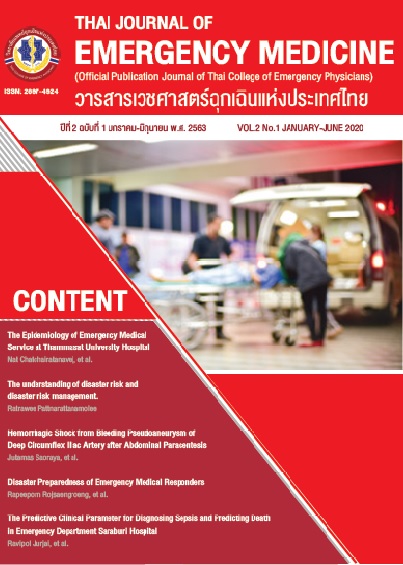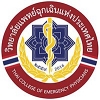The understanding of disaster risk and disaster risk management.
Keywords:
disaster risk management, hazard, vulnerability, exposure and capacityAbstract
Disaster risk management currently focuses on mitigation and preparedness. In term of mitigation, an understanding of disaster risk production is required. Hazard, vulnerability and exposure are the main factors that create disaster risk, while capacity is the tool to reduce disaster risk. These concepts have changed the trend of disaster management to pay attention more to mitigation and preparedness in the last decade. However, quick response and recovery are still necessary. Literature shows that the participation of the local community is a vital factor in enhancing their capacity, which will make them cope with disaster and also diminish their vulnerability. Many studies also encourage the concept of a resilient community, which is required the promotion of the national policy. In a climate-change-related disaster, a multi-aspect solution is required to overcome vulnerabilities and reduce some human activity related to global warming. The early warning system is an example of mitigation that can reduce death and injury. Therefore, the disaster manager should focus more on disaster risk management in the mitigation-preparedness phase
References
Blanchard BW, Canton LG, Owiak CL,Goss KC, McEntire DA, Newsom L, et alL. Principles of Emergency Management Supplement. FEMA, Emergency Management Institute; 2007.
De Smet H, Lagadec P, Leysen J. Disasters out of the box: a new ballgame? J Contingencies Crisis Manag. 2012;20:138-48.
Howard A, Agllias K, Bevis M, Blakemore T. "They'll tell us when to evacuate": The experiences and expectations of disaster-related communicatio don in vulnerable groups. JDisaster Risk Reduct. 2017:22:139-46.
Palttala P, Boano C, Lund R, Vos M. Communication gaps in disaster management percep ptions by experts from governmental and non-governmental organizations. J Contingencies Crisis Manag.2012:20-2-12.
United Nations International. Strategy for Disaster Reduction. Terminology - UNISDR Interet]. 2009 [cted 2018 Aug 21]. Available from: https://www.u .unisdr.org/we/inform/terminology
Jin D, Lin J. Managing tsunamis through early warning systems: A multidisciplnary approach. Ocean Coast Manag. 2011;54:189-99.
Shaw R, Goda K. From Disaster to Sustainable Civil Society: The Kobe Experience. Disasters.2004:28:16-40.
Kelman I, Gaillard JC, Mercer J. Climate Change's Role in Disaster Risk Reduction's Future: Beyond Vulnerability and Resilience. Int J Disaster Risk Sci. 2015;6:21-7.
IPCC. Climate change 2014: Synthesis report [Internet]. Geneva, Switzerland:The intergovernmental panel on climate change; 2014. Available from: https://www.ipcc.ch/site/assets/uploads/2018/02/AR5_SYR_FINAL_SPM.pdf
Guirguis K, Gershunov A, Tardy A, Basu R. The Impact of Recent Heat Waves on Human Health in California. J Appl Meteor Climatol.2013:53:3-19.
New Zealand ministry for the Environment.Evidence for climate change Ministry for the Environment [Internet]. 2018 [cited 2019 Apr12]. Available from: http://ww.mfe.govt.nz/climate-change/why-climate-change-mat-ters/evidence-climate-change
Leaning J, Guha-Sapir D. Natural disasters, armed conflict, and public health. N Engl J Med. 2013:369:1836-42.
Thaiwater er. 2011 Thailand flood execute summary [Internet]. 2012. Available from: http://ww.thaiwater.net/web/attachments 379 thailand9620flood920es%620v2.pdf
Cardona O. The need for rethinking the concepts of vulnerability and risk from a holistic perspective: a necessary review and criticism for effective risk management. In: Frerks G, Bankoff G, Hilhorst D, editors. Mapping vulnerability Disasters, develop-ment and people. London, Sterling & VA:Earthscan; 2004.
Perry RW. What Is a Disaster? In: Rodrguez H, Quarantelli EL, Dynes RR, editors. Handbook of Disaster Research [Internet]. New York, NY: Springer New York; 2007 [cited 2019 Apr 13]- p. 1-15. (Handbooks of Sociology and Social Research). Available from: https://doi.org/10.1007/978-0-387-32353-4_1
Wisner B, Gaillard JC, Kelman I. Framing disaster: theories and stories seeking to understand Hazards, vulnerability and risk. Handbook of Hazards and Disaster Risk Reduction; 2012.
Bankoff G, Frerks GE, Hilhorst DJM. Mapping Vulnerability, Disasters, Development and People. London: Earthscan; 2003.
Gaillard JC. Vulnerability, capacity and resilience: Perspectives for climate and development policy. J Int Dev. 2010;22:218-32.
Wisner B, Blaikie P, Cannon T, Davis I. At risk: natural hazards, people's vulnerability and disasters. second. London: Routledge; 2004.
Waugh WL, Streib G. Collaboration and leadership for effective emergency management. Public Adm Rev. 2006:66:131-40.
Scolobig A, Prior T, Schroter D, Jorin J, Patt A. Towards people-centred approaches for effective disaster risk management: balancing rhetoric with reality. Int J Disaster Risk Reduct. 2015;12:202-12.
Swords J, O'Keefe P, O'Brien G, Gadema Z. Approaching disaster management through social learning. Disaster Prev. Manag. 2010;19:498-508.
Healy A, Malhotra N. Myopic Voters and Natural Disaster Policy. Am Political Sci Rev.2009:103:387-406.
Vatanpour S, Hrudey S, Dinu I. Can Public Health Risk Assessm ment Using Risk Matrices Be Misleading? Int J Environ Res Public Health. 2015:12:9575-9588. doi:10.3390/ijerph120809575
Davis I, Haghebaert B, Peppiatt D. Social Vulnerability and Capacity Analysis. In Geneva; 2004.
Phibbs S, Kenney C, Solomon M. Nga Mowaho: an analysis of Maori responses to the Christchurch earthquakes. Kotuitui: New Zealand Journal of Social Sciences Online. 2015:10:72-82.
Manyena SB. The concept of resilience revisited. Disasters. 2006:30:433-50.
Manyena SB, O'Brien G, O'Keefe P, Rose J. Editorial disaster resilience: a bounce back or bounce forward ability? Local Environ.2011:16:1-8.
Twigg J. Characteristics of a Disaster-Resilient Community (2nd, revised and expanded edition). London: DRR Interagency Co-ordination Group; 2009.
Cannon T. World Disasters Report 2014 - Chapter 4 - IFRC [Internet]. 2014 [cited 2018 Aug 22]. Available from: http://www.ifrc.org/publications-and-reports/world-disasters-report/world-disasters-report-2014/world-disasters-report-2014--chapter-4/
Delica ZG, Andaya E-C. Citizenry-Based & Development-Oriented Disaster Response: Experiences and Practices in Disaster Management of the Citizen's Disaster Response Network in the Phillipines Internet].Asian Disaster Preparedness Center, 2001. Available from: https://www.r researchgate. net/publication/272791511_Citizenry-Based_Developmen nt-Oriented_Disaster_Response_Experiences and Practi ices in Disaster Management_of_the_Citizen's_Disaster_Response_Network_in_the_Phillipines
Fraser S. Tsunami evacuation: lessons from the great east Japan earthquake and tsunami of March 11th 2011 [Internet]. Lower Hutt. New Zealand: GNS Science; 2012 [cted 2018 Aug 15]. Available from: http://www.gns.cri.nz/static/pubs/2012/SR%6202012-017.pdf

Downloads
Published
How to Cite
License
บทความที่ได้รับตีพิมพ์ในวารสารเวชศาสตร์ฉุกเฉินแห่งประเทศไทย ถือเป็นเป็นลิขสิทธิ์ของ วิทยาลัยแพทย์เวชศาสตร์ฉุกเฉินแห่งประเทศไทย
กรณีที่บทความได้รับการตีพิมพ์ในวารสารเวชศาสตร์ฉุกเฉินแห่งประเทศไทยแล้ว จะตีพิมพ์ในรูปแบบอิเล็กทรอนิกส์ ไม่มีสำเนาการพิมพ์ภายหลังหนังสือเผยแพร่เรียบร้อยแล้ว ผู้นิพนธ์ไม่สามารถนำบทความดังกล่าวไปนำเสนอหรือตีพิมพ์ในรูปแบบใดๆ ที่อื่นได้ หากมิได้รับคำอนุญาตจากวารสารเวชศาสตร์ฉุกเฉินแห่งประเทศไทย



